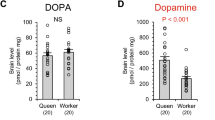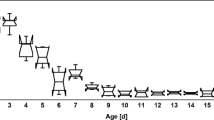Summary
The rate of protein synthesis by the neurosecretory cells in the pars intercerebralis and in the corpora allata was determined by autoradiography. Bees that forage throughout the day display a daily rhythm in that rate; the synthesis curve could be shifted considerably in each of two different training experiments.
The total amount of protein synthesized per day is distinctly greater for bees that collect all day than for those with activity limited by the training schedule.
The corpora allata also exhibit a daily rhythm in protein synthesis, and this too can be altered by training. The relationship to collecting activity are less clear than in the case of the pars intercerebralis, but are similar in direction of shift.
Similar content being viewed by others
References
Beattie, T.M.: Histology, histochemistry and ultrastructure of neurosecretory cells in the optic lobe of the cockroach,Periplaneta americana. J. Insect Physiol.17, 1843–1855 (1971)
Beling, I.: Über das Zeitgedächtnis der Bienen. Z. vergl. Physiol.9, 259–338 (1925)
Biedermann, M.: Neurosekretion bei Arbeiterinnen und Königinnen vonApis mellifica L. unter natürlichen und experimentellen Bedingungen. Z. wiss. Zool.170, 255–308 (1964)
Bishop, G.H., Briggs, A.P., Ronzoni, E.: Osmotic effects of hemolymph constituents in bee larvae. J. Biol. Chem.66, 77 (1925)
Clegg, J.S., Evans, D.R.: The physiology of blood trehalose and its function during flight in the blowfly. J. exp. Biol.38, 771–792 (1961)
Cymborowski, B.: Investigation on the neurohormonal factors controlling circadian rhythm of locomotor activity in the house cricket (Acheta domesticus L.). I. The role of the brain and the subesophageal ganglion. Zool. Poloniae,20, 103–125 (1975)
Cymborowski, B., Dutkowski, A.: Circadian changes in RNA synthesis in the neurosecretory cells of the brain and subesophageal ganglion of the house cricket. J. Insect Physiol.15, 1187–1197 (1969)
Cymborowski, B., Dutkowski, A.: Circadian changes in protein synthesis in the neurosecretory cells of the central nervous system ofAcheta domesticus. J. Insect Physiol.16, 341–348 (1970)
Cymborowski, B., Dutkowski, A.: Control of the circadian rhythm in the house cricket. J. Insect Physiol.19, 1423–1440 (1973)
Friedman, St.: Control of trehalose synthesis in the blowfly,Phormia regina Meig. J. Insect Physiol.13, 395–405 (1967)
Frisch, K.v.: Über die „Sprache“ der Bienen, eine tierpsychologische Untersuchung. Zool. Jb. Physiol.40, 1–186 (1923)
Frisch, K.v.: Tanzsprache und Orientierung der Bienen. Berlin-Heidelberg-New York: Springer 1965
Gersch, M.: Kontrolle der circadianen Rhythmik des Trehalosegehaltes der Hämolymphe vonPeriplaneta americana. Zool. Jb. Physiol.80, 1–15 (1976)
Harbers, E.: Autoradiographie als histochemisches Untersuchungsverfahren. In: Handbuch der Histochemie (ed. W. Graumann, K. Neumann) I/1, pp. 400–518. Stuttgart: G. Fischer-Verlag 1958
Heinzeller, Th.: Bau des Ocellarnervs und Einfluß der Ocellen auf circadiane Änderungen im neurokrinen System der Honigbiene. Diss. Univ. München (1974)
Kreyszig, E.: Statistische Methoden und ihre Anwendung. Göttingen: Vandenhoeck & Ruprecht 1965
Laere, O.v.: Ultrastructure of the corpora cardiaca in the Honeybee. J. Apic. Res.12, 81–98 (1973)
Lea, A.O., Thomsen, E.: Cycles in the synthetic activity of the medial neurosecretory cells ofCalliphora erythrocephala and their regulation. Mem. Soc. Endocr.12, 345–347 (1962)
Nishitsutsuji-Uwo, J., Petropulos, S.F., Pittendrigh, C.S.: Central nervous system control of circadian rhythmicity in the cockroach. I. Role of the pars intercerebralis. Biol. Bull. Mar. biol. Lab. (Woods Hole)133, 679–696 (1967)
Nishitsutsuji-Uwo, J., Pittendrigh, C.S.: Central nervous system control of circadian rhythmicity in the cockroach. III. The optic lobes, locus of the driving oscillation? Z. vergl. Physiol.58, 14–46 (1968)
Normann, T.C.: Neurosecretory cells in insect brain and production of hypoglycaemic hormone. Nature (Lond.)254, 259–261 (1975)
Renner, M.: Über die Haltung von Bienen in geschlossenen, künstlich beleuchteten Räumen. Naturw.42, 539–540 (1955)
Roberts, S.K., de F.: Circadian activity rhythms in cockroaches. Effects of optic lobe lesions. J. comp. Physiol.88, 21–30 (1974)
Roberts, S.K. de F., Skopik, S.D., Driskill, R.J.: Circadian rhythms in cockroaches: Does brain hormone mediate the locomotor cycle? In: Biochronometry (ed. M. Menaker Washington: National Academy of Science 1971
Sachs, L.: Angewandte Statistik, 4. Aufl. Berlin-Heidelberg-New York: Springer 1974
Sokolove, P.G., Loher, W.: Role of eyes, optic lobes and pars intercerebralis in locomotory and stridulatory circadian rhythms ofTeleogryllus commodus. J. Insect Physiol.21, 785–799 (1975)
Steele, J.E.: Occurrence of a hyperglycaemic factor in the corpus cardiacum of an insect. Nature (Lond.)192, 680–681 (1961)
Thomsen, E., Lea, A.O.: Control of the medial neurosecretory cells by the corpus allatum inCalliphora erythrocephala. Gen. comp. Endocr.12, 51–57 (1968)
Vejbjerg, K., Normann, T.C.: Secretion of hyperglycaemic hormone from the corpus cardiacum of flying blowflies,Calliphora erythrocephala. J. Insect Physiol.20, 1189–1192 (1974)
Welch, B.L.: The generalization of “Student's” when several different population variances are involved. Biometrica34, 28–35 (1947)
Author information
Authors and Affiliations
Additional information
We thank Mrs. L. v. Szczepanski for valuable assistance in preparing the autoradiographs; funds and equipment for their preparation were supplied by the Gesellschaft für Strahlen- und Umweltforschung m.b.H. Neuherberg/München (Institute of Biology: Prof. O. Hug).
Rights and permissions
About this article
Cite this article
Vogel, H., Heinzeller, T. & Renner, M. Daily protein synthesis in the pars intercerebralis and corpora allata ofApis mellifica L. with and without training to a foraging schedule. J. Comp. Physiol. 118, 51–60 (1977). https://doi.org/10.1007/BF00612336
Received:
Issue Date:
DOI: https://doi.org/10.1007/BF00612336




